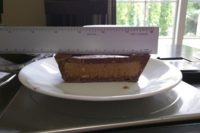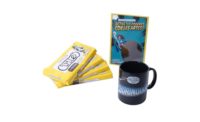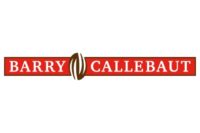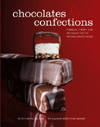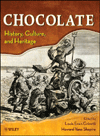Candara gets its own brand with the iBar
Melissa Thibeault, Candara’s controller, details what it’s like to bring a chocolate bar from conception to market.



Candara has the ability to do moulding and depositing for both small-batch and large-scale manufacturing for private-label and comanufacturing projects.


Melissa Thibeault, Candara's controller, shows Crystal Lindell, Candy Industry Magazine's managing editor, chocolate bars coming off the line.



Candy Industry Magazine Managing Editor Crystal Lindell, left, with Candara's David A. Lysak, v.p., and Melissa Thibeault, controller, at the company's offices in Quebec.








The iBar is Melissa Thibeault’s baby. The Candara controller has been working on the fruit and chocolate bar since 2012.
That’s when Candara decided it wanted to create its own branded product. Originally they were looking to create a better-for-bar or something with dark chocolate.
“But we were looking at the numbers, and the market is milk chocolate. Everybody says they want to eat dark chocolate, but they buy milk chocolate,” Thibeault says.
So Thibeault, in collaboration with David A. Lysak, v.p. of Candara, and Raymond Guilbault, president of Candara, decided to go with the more classic milk chocolate. However, they still wanted a better-for-you appeal, so they also had the idea of adding fruit to it — real, whole fruit.
“We come from a background of nutrition bars, and we sold that company some time ago, and we were trying to use some of that knowledge in formatting a moulded chocolate bar,” Lysak says.
Then, they had to figure out which fruits. They thought of blood orange, and an orange-cranberry mix, but neither was quite right. So they decided on a cranberry milk chocolate bar, a blueberry milk chocolate bar, and a raisin milk chocolate bar.
But next they had to choose which chocolate to use. They literally tasted more than 100 different varieties before fate intervened. They were in a meeting with a third party, and he happened to have four different types of chocolate with him — and they finally found one they loved.
“The creaminess, and the sweetness of the chocolate, the mouthfeel — it’s a premium chocolate,” Thibeault says.
After that they had to decide exactly how much fruit they were going to use in each bar and this is where things got complicated. They originally tried to do as much as 30 percent inclusions, but it was too much. They then they went the other way and tried 10 percent, but that wasn’t quite enough. Eventually, they settled on 20 percent.
But then there was the matter of evenly distributing the inclusions throughout the bar. After experimenting with the process, they realized that the only way to get it just right is to split the bar into five squares and deposit fruit into each square.
“It’s not a ribbon. It’s a one-shot depositor, so we’re supposed to have the same amount of fruit in each square,” explains Thibeault. “And this is very important, so in every bite [we want] some fruit.”
They also messed around with texture ingredients, like cereals, quinoa and even apple chips. But the apple chips just got soft during the chocolate making process. So they decided to add rice crisps to give it that something special.
Guilbault is what Thibeault calls a perfectionist though, so even after they settled on all the ingredients, Guilbault insisted that the bottom of the bar be smooth, so as not to include any bumps.
“We worked with the chocolate manufacturer to have less viscosity, so the fruit can be more fluid in the chocolate and be more homogenous, so the bottom can be all flat,” Thibeault explains.
Of course, figuring out what kind of product to create is only half the battle — there’s also the matter of coming up with a brand name. They decided to call it the iBar to convey the idea that consumers could see it as, “my bar.” Yes, they know it is similar to Apple’s popular brand of products like the iPhone, but the name has no relation to the computer company.
Then there was the matter of the packaging. On their first go, they ended up with a look that seemed to convey to a lot of retail buyers that it was an energy bar — not quite what they were going for.
“Everybody said, ‘Oh that’s an energy bar. So we failed at first. And we recognized it,” Thibeault says.
So they went back to the drawing board, and came back with packaging that features richer colors, large images of real fruit and a smaller logo. They’re planning the official launch of the new design at the 2016 Sweets and Snacks Expo.
And they’re hoping to piggyback off of some of the success other major players are having in the premium better-for-you chocolate category — companies like Mars which released its goodnessknows bar and Hershey, which released its Brookside bars.
The iBar itself is a delicious mix of rich chocolate and tempting fruit that Candara is able to make in their own facility in Montreal, Canada. The lines at the plant are also ideal for business development partners looking for everything from a facility to an R&D team.
They have the capacity to work with major companies, and also do small batches for specialty development chocolate. It’s a moulding facility and they can deposit with inclusions and deposit with a soft center. In fact, it even features a two-deep depositing line.
The whole facility relies heavily on automation.
“Everything is automated. Because we want to reduce the touch, because when you touch a chocolate it leaves a mark, so it’s not a good appearance,” Thibeault says.
As for the iBar Theibeault says they’ve learned a lot along the way, and it’s information that they not only plan to use as they move forward with the iBar brand, but also to help other manufacturers who use their facility.
“It’s a hard experience. It’s a very hard experience, because I always thought it was easy at first. But that’s not the reality,” Theibeault says. “It’s my baby, but I have to patient.”
Read more about Quebec's Chocolate Scene:
Looking for a reprint of this article?
From high-res PDFs to custom plaques, order your copy today!





